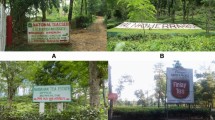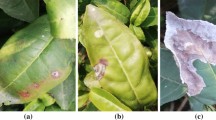Abstract
The discovery and localization of tea leaf blight (TLB) are crucial for tea-producing areas to resist the disease in good time and enhance tea yield and quality. TLB images captured in natural scenes present complex issues such as lighting variations, partial occlusion, and small spots. Traditional manual and machine learning-based methods cannot meet the requirements of detection accuracy and speed. To address these issues, a detection method for TLB in natural scene images based on a lightweight and efficient LC3Net model is proposed. In this method, the Retinex algorithm is chosen to enhance the contrast and minimize the influence of uneven lighting. The LC3Net model can detect leaves with different morphologies while reducing the computational cost. It is achieved by implementing image normalization (IN) and reducing the down-sampling frequency of the backbone network. The method can effectively detect mildly diseased and partially occluded leaves due to the integration of a channel attention module (CAM) and a weighted bi-directional feature pyramid structure in the LC3Net model. The experimental results indicate that the LC3Net model achieves an AP value of 92.29%, which is 5.46% and 4.91% higher than the results of Faster-RCNN and EfficientDet-D0 models, respectively. When compared to the baseline model YOLOv5s, our proposed LC3Net improves by 2.56% over the test data. Furthermore, the model has a parameter size of only 2.16M and achieves a detection speed of 63.5 frames per second (FPS), which provides a good solution for TLB detection in natural scene images.
















Similar content being viewed by others
References
Alshammari H, Gasmi K, Ben Ltaifa I, Krichen M, Ben Ammar L, Mahmood MA (2022) Olive disease classification based on vision transformer and CNN models. Comput Intell Neurosci 2022:3998193
Ashourloo D, Aghighi H, Matkan AA, Mobasheri MR, Rad AM (2016) An investigation into machine learning regression techniques for the leaf rust disease detection using hyperspectral measurement. IEEE J Select Topics Appl Earth Obs Remote Sens 9(9):4344–4351
Bi C, Wang J, Duan Y, Fu B, Kang J-R, Shi Y (2022) MobileNet based apple leaf diseases identification. Mob Netw Appl 1–9.
Bochkovskiy A, Wang C-Y, Liao H-YM (2020) Yolov4: Optimal speed and accuracy of object detection. arXiv preprint arXiv:2004.10934.
Chaliha C, Kalita E (2020) Blister blight disease of tea: An enigma. In: Diagnostics of Plant Diseases, IntechOpen. https://doi.org/10.5772/intechopen.95362.
Cooper TJ, Baqai FA (2004) Analysis and extensions of the Frankle-McCann Retinex algorithm. J Electron Imaging 13(1):85–92
Dhaka VS, Meena SV, Rani G, Sinwar D, Kavita I, M.F., Wozniak, M. (2021) A survey of deep convolutional neural networks applied for prediction of plant leaf diseases. Sensors (basel) 21(14):4749. https://doi.org/10.3390/s21144749
Ge Z, Liu S, Wang F, Li Z, Sun J (2021) Yolox: Exceeding yolo series in 2021. arXiv preprint arXiv:2107.08430.
Grauman K, Darrell T (2007) The pyramid match kernel: efficient learning with sets of features. J Mach Learn Res 8(4):725–760
Harakannanavar SS, Rudagi JM, Puranikmath VI, Siddiqua A, Pramodhini R (2022) Plant leaf disease detection using computer vision and machine learning algorithms. Glob Trans Proc 3(1):305–310
Hu G, Yang X, Zhang Y, Wan M (2019) Identification of tea leaf diseases by using an improved deep convolutional neural network. Sustain Comput: Inf Syst 24:100353
Hu G, Wang H, Zhang Y, Wan M (2021) Detection and severity analysis of tea leaf blight based on deep learning. Comput Electr Eng 90:107023
Hu G, Wan M, Wei K, Ye R (2023) Computer vision based method for severity estimation of tea leaf blight in natural scene images. Eur J Agron 144:126756
Johnson J, Sharma G, Srinivasan S, Masakapalli SK, Sharma S, Sharma J, Dua VK (2021) Enhanced field-based detection of potato blight in complex backgrounds using deep learning. Plant Phenom
Larijani MR, Asli-Ardeh EA, Kozegar E, Loni R (2019) Evaluation of image processing technique in identifying rice blast disease in field conditions based on KNN algorithm improvement by K-means. Food Sci Nutr 7(12):3922–3930
Lazebnik S, Schmid C, Ponce J (2006) Beyond bags of features: Spatial pyramid matching for recognizing natural scene categories. In: 2006 IEEE computer society conference on computer vision and pattern recognition (CVPR'06). IEEE. pp. 2169–2178.
Liu J, Wang X (2020) Early recognition of tomato gray leaf spot disease based on MobileNetv2-YOLOv3 model. Plant Methods 16:1–16
Liu B, Ding Z, Tian L, He D, Li S, Wang H (2020) Grape leaf disease identification using improved deep convolutional neural networks. Front Plant Sci 11:1082
Liu Z, Bashir RN, Iqbal S, Shahid MMA, Tausif M, Umer Q (2022) Internet of Things (IoT) and machine learning model of plant disease prediction–blister blight for tea plant. IEEE Access 10:44934–44944
Liu W, Anguelov D, Erhan D, Szegedy C, Reed S, Fu C-Y, Berg AC (2016) Ssd: Single shot multibox detector. Computer Vision–ECCV 2016: 14th European Conference, Amsterdam, The Netherlands, October 11–14, 2016, Proceedings, Part I 14. Springer. pp. 21–37.
Liu S, Qi L, Qin H, Shi J, Jia J (2018) Path aggregation network for instance segmentation. Proceedings of the IEEE conference on computer vision and pattern recognition. 8759–8768.
Ma Y, Tang P, Zhao L, Zhang Z (2021) Review of data augmentation for image in deep learning. J Image Graphics 26:487–502
Pal NR (1996) On minimum cross-entropy thresholding. Pattern Recogn 29(4):575–580
Pan X, Luo P, Shi J, Tang X (2018) Two at once: Enhancing learning and generalization capacities via ibn-net. Proceedings of the European Conference on Computer Vision (ECCV). pp. 464–479.
Redmon J, Farhadi A (2017) YOLO9000: better, faster, stronger. Proceedings of the IEEE conference on computer vision and pattern recognition. 7263–7271.
Redmon J, Farhadi A (2018) Yolov3: An incremental improvement. arXiv preprint arXiv:1804.02767.
Redmon J, Divvala S, Girshick R, Farhadi A (2016) You only look once: Unified, real-time object detection. Proceedings of the IEEE conference on computer vision and pattern recognition. pp. 779–788.
Ren S, He K, Girshick R, Sun J (2015) Faster r-cnn: Towards real-time object detection with region proposal networks. Advances in neural information processing systems, 28.
Sanlier N, Gokcen BB, Altuğ M (2018) Tea consumption and disease correlations. Trends Food Sci Technol 78:95–106
Shorten C, Khoshgoftaar TM (2019) A survey on image data augmentation for deep learning. J Big Data 6(1):1–48
Shuping C, Zhongming S, Hui L (2021) Real-time detection methodology for obstacles in orchards using improved YOLOv4. Trans Chin Soc Agricult Eng (trans CSAE) 37(2):36–43
Sun H, Xu H, Liu B, He D, He J, Zhang H, Geng N (2021) MEAN-SSD: A novel real-time detector for apple leaf diseases using improved light-weight convolutional neural networks. Comput Electron Agric 189:106379
Tan M, Pang R, Le QV (2020) Efficientdet: Scalable and efficient object detection. Proceedings of the IEEE/CVF conference on computer vision and pattern recognition. 10781–10790.
Wang J, Yu L, Yang J, Dong H (2021) DBA_SSD: A novel end-to-end object detection algorithm applied to plant disease detection. Information 12(11):474
Woo S, Park J, Lee J-Y, Kweon IS (2018) Cbam: Convolutional block attention module. Proceedings of the European conference on computer vision (ECCV). pp. 3–19.
Xiao S, Lan G, Yang J, Lu W, Meng Q, Gao X (2023) MCS-GAN: a different understanding for generalization of deep forgery detection. IEEE Trans Multimed 1–13.
Xue Z, Xu R, Bai D, Lin H (2023) YOLO-Tea: a tea disease detection model improved by YOLOv5. Forests 14(2):415
Yang J, Zhang Z, Xiao S, Ma S, Li Y, Lu W, Gao X (2023) Efficient data-driven behavior identification based on vision transformers for human activity understanding. Neurocomputing 530:104–115
Zeng W, Li H, Hu G, Liang D (2022) Lightweight dense-scale network (LDSNet) for corn leaf disease identification. Comput Electron Agric 197:106943
Zhang S, Wu X, You Z, Zhang L (2017) Leaf image based cucumber disease recognition using sparse representation classification. Comput Electron Agric 134:135–141
Zhang P, Yang L, Li D (2020) EfficientNet-B4-Ranger: a novel method for greenhouse cucumber disease recognition under natural complex environment. Comput Electron Agric 176:105652
Zhang K, Wu Q, Chen Y (2021) Detecting soybean leaf disease from synthetic image using multi-feature fusion faster R-CNN. Comput Electron Agric 183:106064
Zhao S, Liu J, Wu S (2022) Multiple disease detection method for greenhouse-cultivated strawberry based on multiscale feature fusion Faster R_CNN. Comput Electron Agric 199:107176
Zhao Y, Xiao S, Yang J, Lu W, Gao X (2023) No-reference quality index of tone-mapped images based on authenticity, preservation, and scene expressiveness. Signal Process 203:108782
Acknowledgements
This work was supported by the National Natural Science Foundation of China (Grant No. 32372632), the Major Natural Science Research Projects in Colleges and Universities of Anhui Province (Grant No. KJ2020ZD03), as well as the Central Government Guides Local Funds of Anhui Province in 2021 (Grant No. K120636001).
Author information
Authors and Affiliations
Contributions
Y.J.: Resources, Conceptualization, Writing—original draft, Visualization, Supervision. L.L.: Conceptualization, Methodology, Writing–original draft, Software, Visualization, Writing—review & editing, Validation. M.W.: Methodology, Software, Visualization, Writing—original draft, Writing—review & editing. G.H.: Resources, Conceptualization, Methodology, Writing—original draft, Writing—review & editing, Supervision. Y.Z.: Data curation, Validation, Writing—review & editing.
Corresponding author
Ethics declarations
Conflict of interest
The authors declare that they have no known competing financial interests or personal relationships that could have appeared to influence the work reported in this paper.
Additional information
Publisher's Note
Springer Nature remains neutral with regard to jurisdictional claims in published maps and institutional affiliations.
Rights and permissions
Springer Nature or its licensor (e.g. a society or other partner) holds exclusive rights to this article under a publishing agreement with the author(s) or other rightsholder(s); author self-archiving of the accepted manuscript version of this article is solely governed by the terms of such publishing agreement and applicable law.
About this article
Cite this article
Jiang, Y., Lu, L., Wan, M. et al. Detection method for tea leaf blight in natural scene images based on lightweight and efficient LC3Net model. J Plant Dis Prot 131, 209–225 (2024). https://doi.org/10.1007/s41348-023-00807-8
Received:
Accepted:
Published:
Issue Date:
DOI: https://doi.org/10.1007/s41348-023-00807-8




